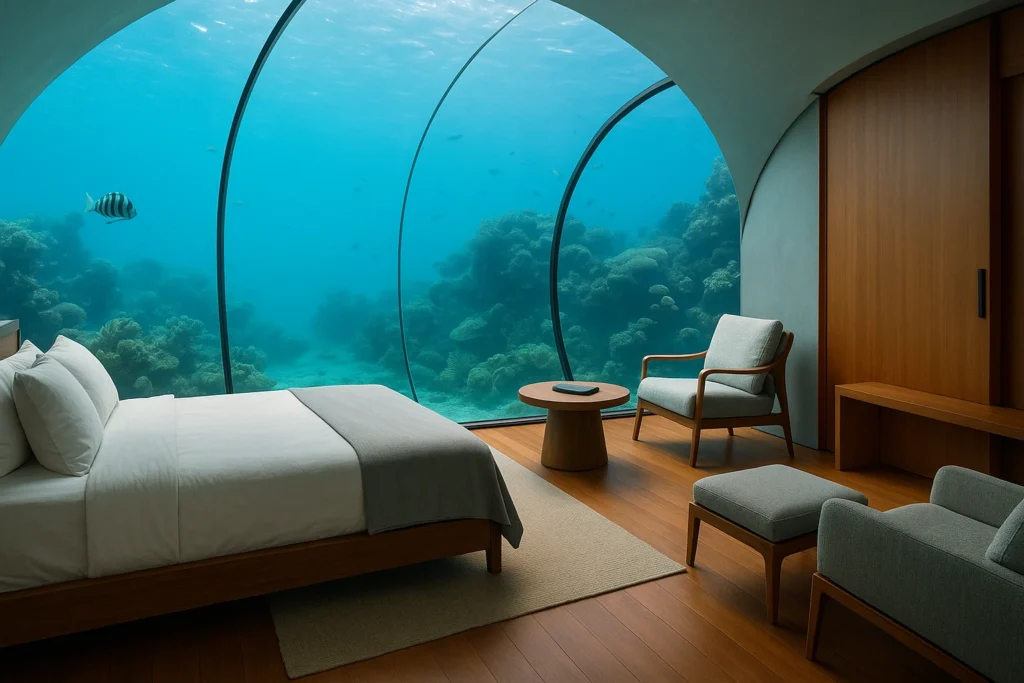Introduction: The Allure of the Deep Blue
The human fascination with underwater living dates back centuries, from Jules Verne’s visionary “20,000 Leagues Under the Sea” to Jacques Cousteau’s pioneering aqualung expeditions. Today, this fascination has materialized into a booming sector of luxury hospitality that combines cutting-edge engineering with unparalleled marine experiences. As we enter 2025, underwater hotels have evolved from novelty attractions to sophisticated habitats that offer guests a transformative connection with the ocean’s mysteries.
This comprehensive guide explores every facet of underwater hospitality, from its historical roots to its technological innovations, environmental impacts, and future possibilities. We’ll dive deep into the world’s most spectacular underwater accommodations, examine the complex engineering behind them, and consider what this emerging trend reveals about the future of luxury travel in an era of climate consciousness.
Chapter 1: The Historical Depths of Underwater Living
Early Visions and Experiments
The concept of underwater habitation has captivated inventors and dreamers for generations:
19th Century Foundations
- 1851: The first diving bell hotels proposed at London’s Great Exhibition
- 1870: Jules Verne’s “20,000 Leagues” popularizes underwater living concepts
- 1895: First practical underwater chamber designs patented
20th Century Breakthroughs
- 1930s: Early diving helmet technology inspires underwater room concepts
- 1960s: Cousteau’s Conshelf projects prove extended underwater living possible
- 1980s: First commercial underwater structures appear
Pioneering Underwater Hotels
The journey from concept to reality:
Jules’ Undersea Lodge (1986)
- Converted marine research lab off Florida
- Requires scuba certification for access
- Still operational today as historic landmark
Utter Inn (1993)
- Swedish artist’s minimalist underwater room
- Sleeps two beneath Lake Mälaren
- Proved small-scale underwater tourism viable
Ithaa Undersea Restaurant (2005)
- Maldives’ first permanent underwater structure
- All-acrylic dining room 16 feet below surface
- Became prototype for future luxury designs
Chapter 2: Modern Underwater Hotel Engineering
Structural Design Innovations
Creating habitable spaces underwater requires solving extraordinary challenges:
Pressure Resistance Solutions
- Acrylic vs. glass: Why 7-inch acrylic dominates
- Reinforced concrete techniques from offshore oil industry
- Modular construction approaches
Life Support Systems
- Air recycling and oxygen replenishment
- Humidity and temperature control
- Emergency power and evacuation
Marine Integration
- Coral-friendly exterior materials
- Current deflection designs
- Light pollution mitigation
Construction Process
Step-by-step from concept to operation:
- Site selection and environmental impact studies
- Offshore fabrication of modules
- Controlled submersion and positioning
- Connection to surface infrastructure
- Marine life integration period
- Final safety inspections
Chapter 3: The World’s Most Spectacular Underwater Hotels
The Muraka – Conrad Maldives Rangali Island
Specifications:
- Depth: 16 feet below surface
- Size: Two-level 600 sqm villa
- Structure: Steel-reinforced acrylic dome
- Special Features: Retractable master bed for surface viewing
Guest Experience:
- Private butler and chef
- Marine biologist on call
- Customized lighting for optimal marine viewing
Atlantis The Palm – Dubai
Underwater Suites:
- Neptune Suite: 1,475 sqft with aquarium views
- Poseidon Suite: Two bedrooms with tunnel access
- Special Features: Interactive aquarium lighting controls
Unique Offerings:
- Underwater wedding packages
- Marine animal encounters
- Night diving experiences
Lovers Deep – Caribbean
Submarine Conversion:
- Former research submarine
- Fully customizable interiors
- Mobile underwater accommodation
Romantic Packages:
- Private champagne dinners
- Underwater photography sessions
- Custom cruise itineraries
Chapter 4: The Science of Underwater Living
Human Physiology Under Pressure
How underwater habitats affect guests:
Air Composition
- Optimal oxygen/nitrogen balance
- Humidity control challenges
- Air recycling efficiency
Psychological Effects
- “Blue mind” benefits
- Submersion disorientation
- Marine life interaction therapy
Safety Considerations
- Emergency decompression protocols
- Fire suppression systems
- Storm contingency plans
Marine Ecosystem Interactions
How hotels affect their environments:
Positive Impacts:
- Artificial reef creation
- Marine research opportunities
- Conservation funding
Negative Impacts:
- Construction disruption
- Light pollution concerns
- Waste management challenges
Chapter 5: The Business of Underwater Hospitality
Market Analysis
Current Statistics:
- $3.5 billion global market (2025)
- 78% occupancy rates (industry average)
- $15,000 average nightly rate (luxury segment)
Demographic Trends:
- 55% millennial guests
- 30% honeymoon market
- 15% corporate retreats
Operational Challenges
Unique Management Aspects:
- Specialized staff training
- Marine maintenance requirements
- Weather dependency
Revenue Streams:
- Premium room rates
- Underwater event hosting
- Media and film location fees
Chapter 6: Sustainability and Environmental Impact
Eco-Friendly Innovations
Energy Solutions:
- Solar panel arrays
- Tidal power generation
- Sea water air conditioning
Marine Conservation:
- Coral propagation programs
- Fish population studies
- Plastic capture initiatives
Certification Programs
Emerging standards for underwater hospitality:
Blue Star Designation
- Energy efficiency benchmarks
- Marine impact assessments
- Conservation investment requirements
Green Fin Certification
- Sustainable seafood policies
- Reef-safe material standards
- Guest education components
Chapter 7: The Future of Underwater Hospitality
Emerging Technologies
Next-Gen Concepts:
- Floating underwater hotel cities
- 3D-printed coral-integrated structures
- Hydrothermal vent energy systems
Experience Enhancements:
- Augmented reality marine guides
- Underwater virtual windows
- Holographic entertainment systems
Market Expansion Predictions
2026-2030 Projections:
- Antarctic underwater lodges
- Deep-sea research hotels
- Space-underwater hybrid resorts
Democratization Trends:
- Modular mid-range options
- Underwater hostel concepts
- Day experience packages
Chapter 8: Cultural and Social Impacts
Changing Travel Preferences
How underwater stays reflect broader trends:
Experience Over Possessions
- Shift from luxury goods to luxury experiences
- Social media driven demand
- Personal transformation focus
Climate Consciousness
- Carbon offset expectations
- Eco-education demand
- Sustainable luxury movement
Architectural Influence
Underwater design affecting other sectors:
Land-Based Hotel Trends
- Aquarium-inspired interiors
- Water-integrated architecture
- Marine-themed wellness spaces
Urban Development
- Subsurface expansion concepts
- Flood-resistant designs
- Blue space integration
Chapter 9: Comparative Analysis
Underwater vs. Traditional Luxury Hotels
Experience Differentiation:
- Immersion vs. observation
- Exclusivity factors
- Memory creation intensity
Operational Differences:
- Construction complexity
- Maintenance requirements
- Staff specialization needs
Regional Variations
How locations shape underwater hospitality:
Tropical vs. Temperate Models
- Coral reef vs. kelp forest environments
- Seasonal operation considerations
- Marine life viewing differences
Cultural Interpretations:
- Asian minimalist approaches
- Middle Eastern opulence
- European ecological focus
Chapter 10: Practical Considerations for Guests
Choosing Your Underwater Experience
Selection Criteria:
- Depth preferences
- Marine life variety
- Surface connection needs
Preparation Tips:
- Acclimatization strategies
- Photography equipment
- Marine etiquette education
Health and Safety
Medical Considerations:
- Claustrophobia assessments
- Diving medical requirements
- Emergency procedure briefings
Insurance Aspects:
- Specialized travel coverage
- Activity waiver specifics
- Emergency evacuation policies
Conclusion: The Ocean’s Call to Hospitality
As we stand at the threshold of a new era in travel, underwater hotels represent more than just another luxury option—they symbolize humanity’s enduring fascination with the sea and our growing desire to connect with rather than simply observe the natural world. The success of these marine habitats demonstrates that modern travelers seek experiences that combine cutting-edge technology with authentic environmental immersion.
The future of underwater hospitality promises even more remarkable developments, from floating underwater cities to research-focused deep-sea lodges. As the industry matures, it faces the dual challenge of maintaining exclusivity while embracing sustainability—a balance that will determine whether underwater living remains a niche luxury or evolves into a more accessible form of transformative travel.
One thing remains certain: as terrestrial spaces become increasingly familiar, the ocean’s depths offer a final frontier for hospitality innovation, promising experiences that quite literally change our perspective on the world. The age of underwater living has only just begun, and its ultimate potential may be as vast and mysterious as the oceans themselves.



